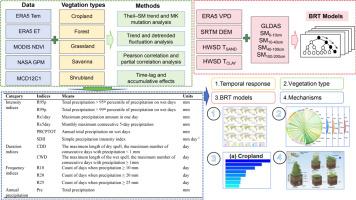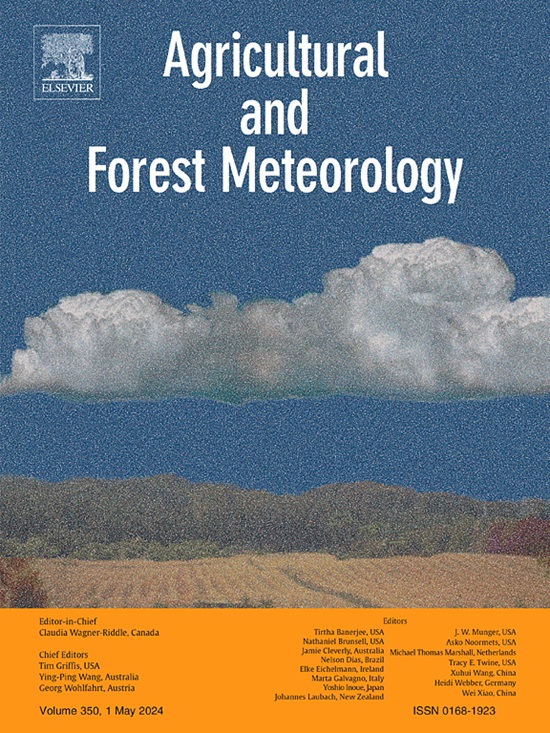Identifying thresholds of time-lag and accumulative effects of extreme precipitation on major vegetation types at global scale
IF 5.6
1区 农林科学
Q1 AGRONOMY
引用次数: 0
Abstract
In the context of increasingly frequent extreme weather events, the temporal response of vegetation (time-lag effect and accumulative effect) to extreme climatic events is a crucial aspect of assessing vegetation dynamics under climate change. However, the contributions and thresholds of environmental factors triggering temporal responses remain unclear, which may significantly impact the assessment of the responsiveness of different ecosystems to environmental changes. Based on daily precipitation data, we evaluated the temporal effects of 11 extreme precipitation indices on the global normalized difference vegetation index (NDVI) in the 21st century and utilized the Boosted Regression Trees (BRT) model to investigate the contributions and thresholds of various factors influencing vegetation's temporal response. The results showed that: (1) although the magnitude of global heavy precipitation events had a declining trend, the amount and duration of precipitation per rainy day showed an upward trend. Spatially, China was one of the countries with the most notable increase in extreme precipitation events globally; (2) only 9.24–36.4 % of global land areas exhibited no temporal effects, the accumulative effects in the five vegetation types (cropland, grassland, forest, shrubland, savanna) collectively exceeded those of the time-lag effects (50.5–76.7 % vs 23.3–49.5 %), and the responses primarily concentrated within the first four months; (3) the temporal effects associated with 89–91 % of global NDVI were associated with heavy precipitation events (R95p and R99p), and greater precipitation frequency accentuated the prominence of temporal effects; (4) the most significant environmental factor influencing vegetation response temporally was vapor pressure deficit (VPD), with contributions ranging from 24.68 % to 47.88 %. Apart from croplands, the temporal response gradually shortened with increasing VPD in the other four vegetation types. Our study enhanced understandings of the comprehensive temporal responses of global vegetation to extreme precipitation events.

确定全球范围内极端降水对主要植被类型的时滞效应和累积效应阈值
在极端天气事件日益频繁的背景下,植被对极端气候事件的时间反应(时滞效应和累积效应)是评估气候变化下植被动态的一个重要方面。然而,引发时间反应的环境因素的贡献和阈值仍不清楚,这可能会严重影响对不同生态系统对环境变化的响应性的评估。基于日降水量数据,我们评估了21世纪11个极端降水指数对全球归一化差异植被指数(NDVI)的时间效应,并利用提升回归树(BRT)模型研究了影响植被时间响应的各种因素的贡献率和阈值。结果表明(1)虽然全球强降水事件的规模呈下降趋势,但每雨日的降水量和持续时间呈上升趋势。从空间上看,中国是全球极端降水事件增加最明显的国家之一;(2)全球仅有 9.24%-36.4% 的陆地面积没有表现出时间效应,五种植被类型(耕地、草地、森林、灌木林地、热带草原)的累积效应总和超过了时滞效应(50.5-76.7% vs 23.3-49.5%)。(3) 与全球 89-91% 的 NDVI 相关的时间效应与强降水事件(R95p 和 R99p)有关,降水频率越高,时间效应越显著;(4) 影响植被时间响应的最重要环境因子是水汽压差(VPD),其贡献率从 24.68% 到 47.88%不等。除耕地外,其他四种植被类型的时间响应随水汽压差的增加而逐渐缩短。我们的研究加深了人们对全球植被对极端降水事件的综合时间响应的理解。
本文章由计算机程序翻译,如有差异,请以英文原文为准。
求助全文
约1分钟内获得全文
求助全文
来源期刊
CiteScore
10.30
自引率
9.70%
发文量
415
审稿时长
69 days
期刊介绍:
Agricultural and Forest Meteorology is an international journal for the publication of original articles and reviews on the inter-relationship between meteorology, agriculture, forestry, and natural ecosystems. Emphasis is on basic and applied scientific research relevant to practical problems in the field of plant and soil sciences, ecology and biogeochemistry as affected by weather as well as climate variability and change. Theoretical models should be tested against experimental data. Articles must appeal to an international audience. Special issues devoted to single topics are also published.
Typical topics include canopy micrometeorology (e.g. canopy radiation transfer, turbulence near the ground, evapotranspiration, energy balance, fluxes of trace gases), micrometeorological instrumentation (e.g., sensors for trace gases, flux measurement instruments, radiation measurement techniques), aerobiology (e.g. the dispersion of pollen, spores, insects and pesticides), biometeorology (e.g. the effect of weather and climate on plant distribution, crop yield, water-use efficiency, and plant phenology), forest-fire/weather interactions, and feedbacks from vegetation to weather and the climate system.

 求助内容:
求助内容: 应助结果提醒方式:
应助结果提醒方式:


